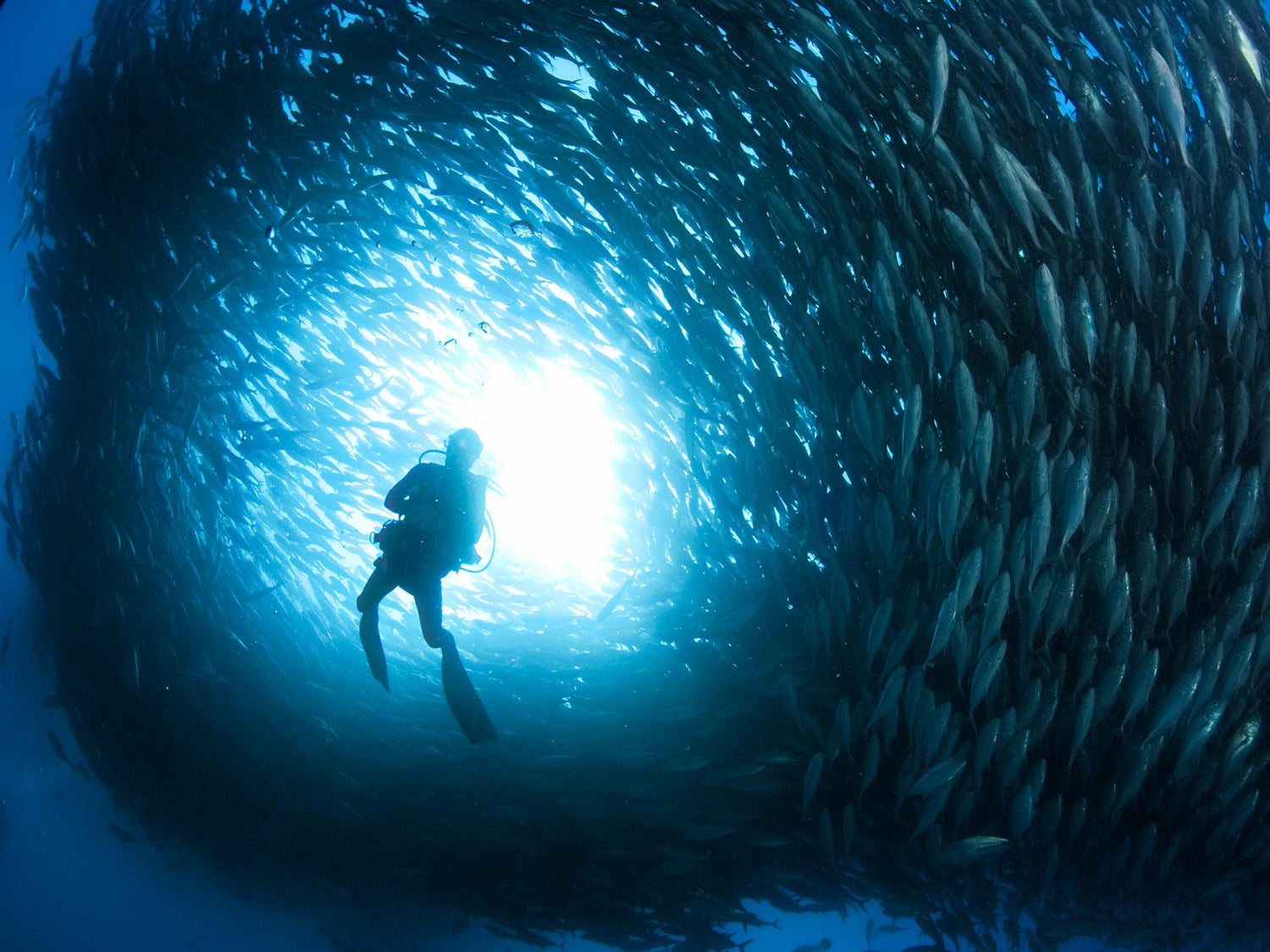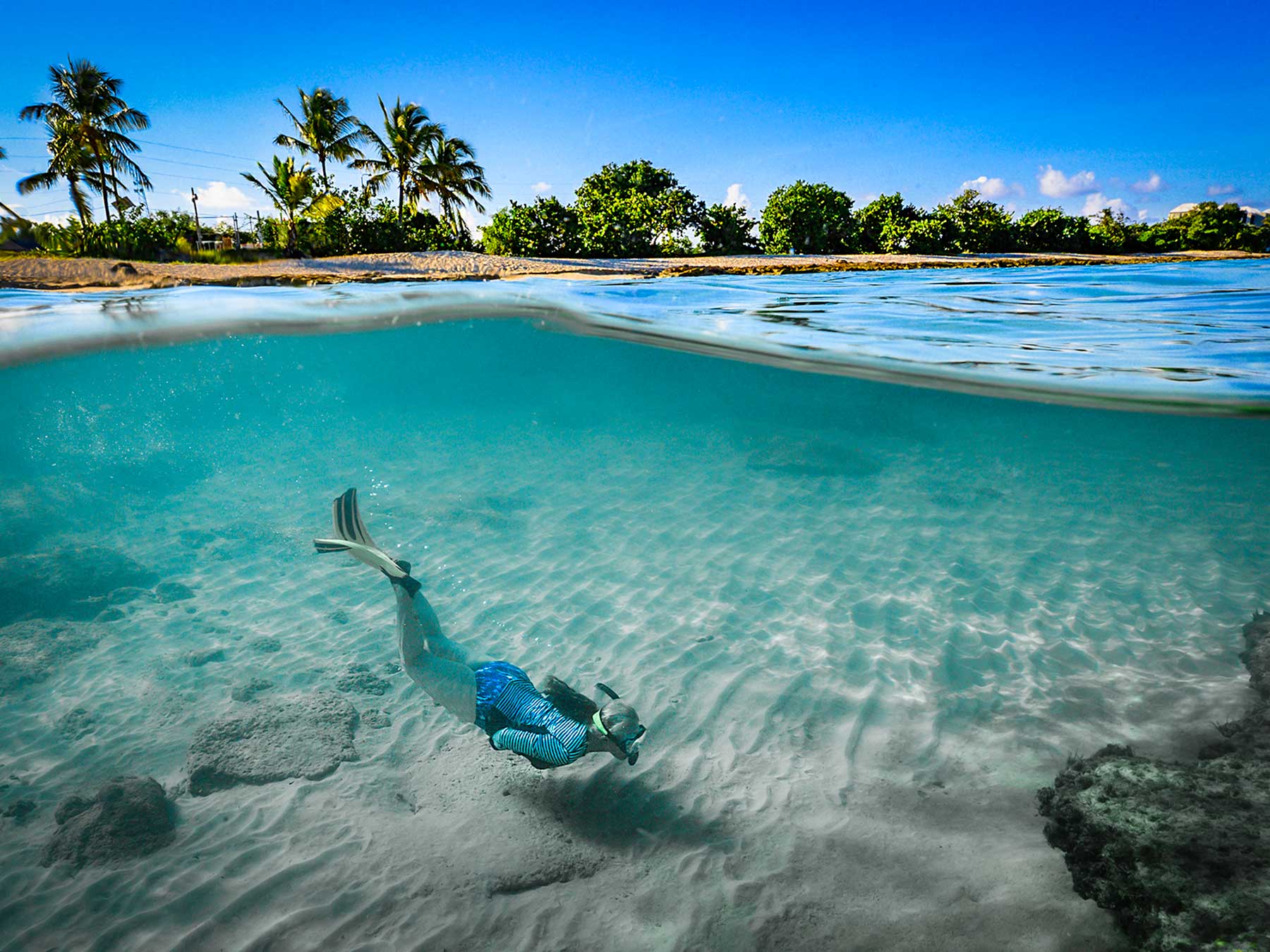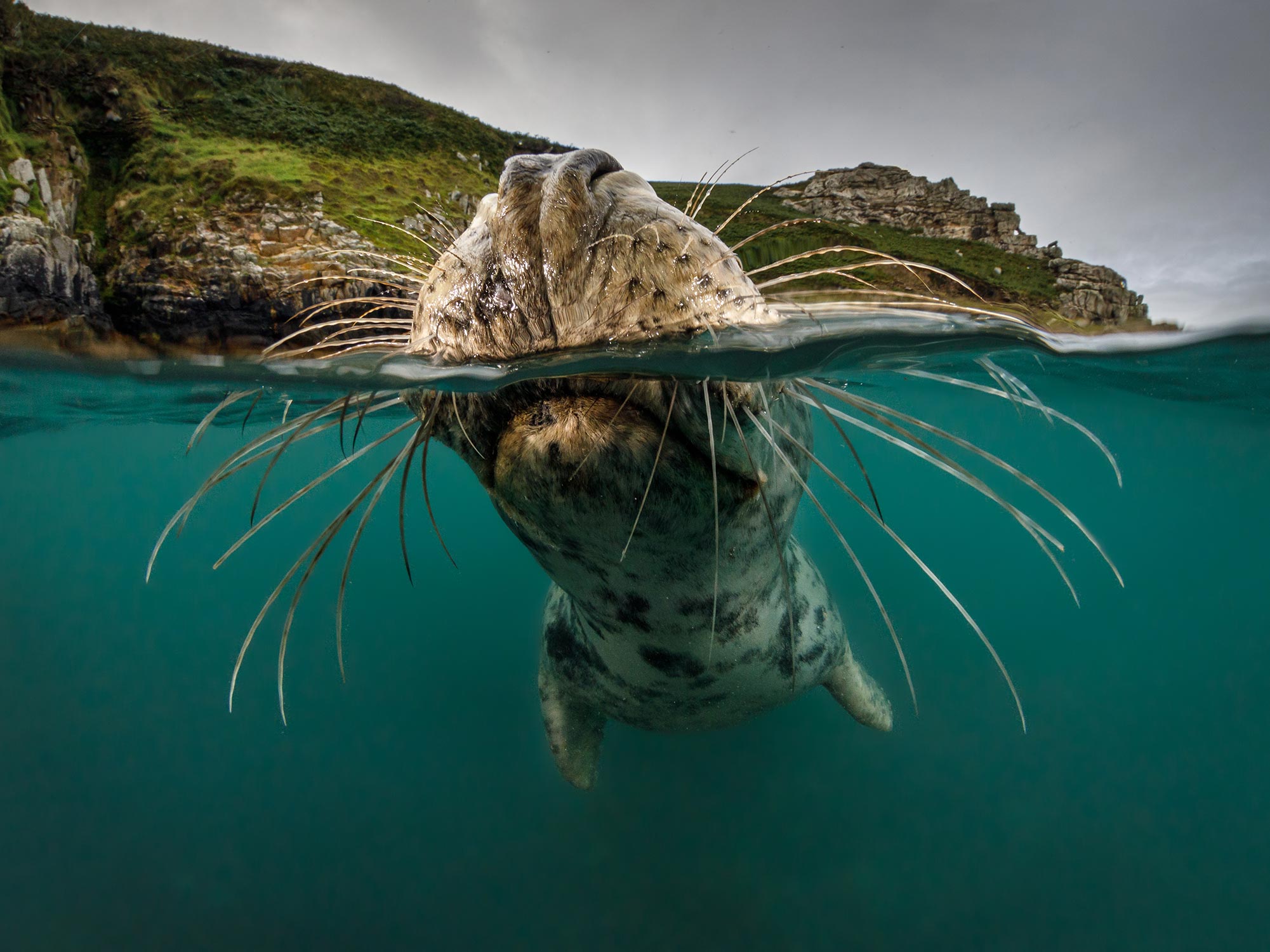By David Valencia
I slowed the car down and switched on my emergency flashing lights. I rolled the window down to hear the “clink, clink” of cowbells and “moo—moo” getting increasingly louder as my friend rolled down the window. Cows crossed the highway and as we waited for the group to pass we admired the morning quiet of an empty road.

The local wildlife, flora, and fauna thrive after a rainfall in Baja, Mexico. © 2021 David Valencia
As we looked around, we couldn't help but notice how green everything looks. After a rain everything in Baja, Mexico turns green and the flowers bloom in a celebration of water. You can see colors splashed on cactus, vines, and trees. It’s so lush and extravagant, I forget that where we are is a desert.
The road to Cabo Pulmo National Park is 2.5 hours of winding and rolling from Cabo San Lucas. We pass the rest of the drive spotting the big five of our Mexican Safari: Horses, Cows, Donkeys, Goats, and Chickens. Now that there’s so much vegetation, all are grazing freely next to the road -- drivers beware. The road abruptly ends and we anxiously drive the rest of the way on a washboard dirt road. After a final jarring from a pot hole I didn’t see, we ran over the final hill to see the morning sun shining golden on the calm water of the bay. Now that’s what we came for.
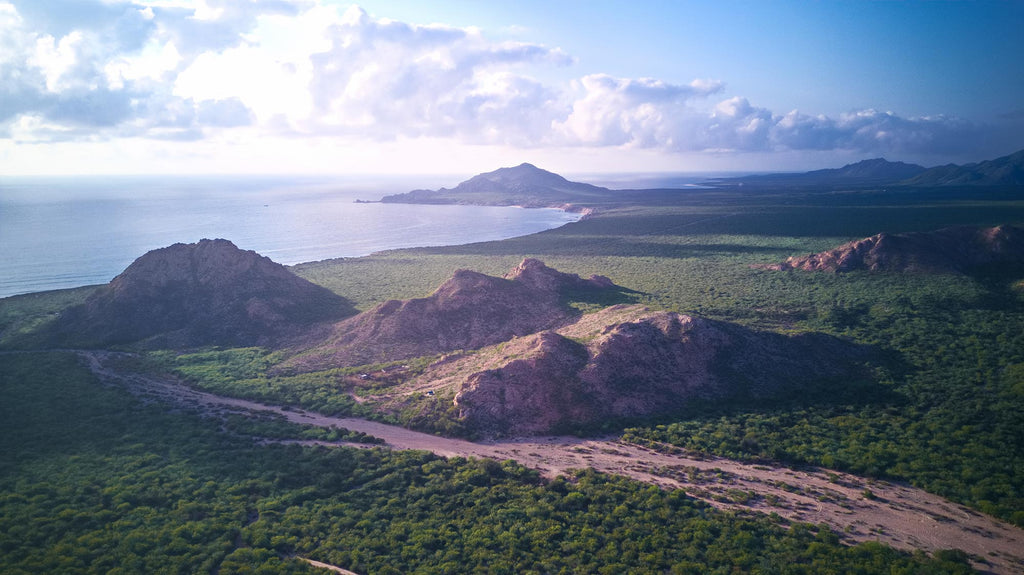
The road the Cabo Pulmo National Park is worth all the effort. © 2021 David Valencia
Many years ago, this bay was not as pristine as its present state. Many came to this area to hire local fishermen to fish everything from huge groupers to sharks. By now, most know the story of Cabo Pulmo. This is a rural town of fishermen and their families that have depended on the ocean for generations. Some 25 years ago town elders became concerned with smaller and smaller catches year after year. They were witnessing the degradation of their livelihoods.
These forward thinking individuals banded together with scientists and government officials to make a decision: the best way to provide for their families was to protect their reef. In 1995 Cabo Pulmo was declared a Natural Protected Area. The beauty and biodiversity that was threatened by overfishing and irresponsible tourism was now safe guarded by community and the law. In 2005 Cabo Pulmo was further deemed a UNESCO World Heritage Site. This National Park is now celebrated as a success story of marine conservation and community involvement throughout the world.

Thanks to the collaborative efforts of fishermen and scientists, a variety of fish now swim among the reef at Cabo Pulmo. © 2021 David Valencia

In 1995 Cabo Pulmo was declared a Natural Protected Area, and by 2005 it was declared a UNESCO World Heritage Site. © 2021 David Valencia
The results of this community committed to conservation is a plethora of life that seems to be a Baja time machine where divers can experience what the reefs used to look like many years ago. These healthy Baja reefs are covered in coral, gargonians, sponges, and of course lots of fish. Even the sand has life as you’ll find bulls eye rays, giant pacific electric ray, and garden eels to the edge of visibility. Not to mention the big stuff like dolphins and the ever popular bull sharks. Research has shown that from the years 1999 and 2009 the biomass in Cabo Pulmo had increased by 463% - the most ever recorded of any marine protected area. In the same time frame, large predators have rebounded more than 1000%. The statistics are incredible and on your dives you can see the difference.

Cabo Pulmo's biomass growth has exceeded any on record yet, a stunning testament to grassroots collaboration and conservation. © 2021 David Valencia
Where to Dive
I have had the great opportunity to dive here countless times over the nine years that I have resided in Baja as a guide and as a guest. So I feel like I have a good handle on what everyone comes here to see. There are a variety of dive sites to visit, but for the photographers out there I recommend El Vencedor (otherwise known as the wreck), El Bajo, El Islote, El Cantilito, the small sea lion colony and wherever the jacks can be found. The best time for bull sharks, huge school of jacks, and best conditions are August-December. As a heads up there are some rather outdated marine park regulations during the busy season (Sept.-Dec.) that limit guests to one dive on the most popular dive sites per day. So I recommend multiple days of diving here to make sure you can have the best sightings.

El Vencedor, El Bajo, El Islote, and El Cantilito are great dive sites for photographers. Peak months to see Bull Sharks and schools of Jacks are August through December. © 2021 David Valencia
My trip this time led me to El Vencedor to start, as we heard there were lots of bull sharks. We descended into liquid blue as the visibility seemed incredible. Due to the long standing protection of this area, huge schools of fish like yellowtail snappers are the first thing that catch my eye. Actually they are hard to miss as the school is literally the size of a building. These fish are an important source for food for the larger predators like groupers, amberjacks, rooster fish, and of course bull sharks. The predators are keeping a watchful eye on the snappers’ every move. We see the first shark swimming undeterred toward us, turning at the last moment. The sharks are conservative in their movements and they must feed mostly at night as we observe them swimming slowly and never do we see them jumping at the opportunity to attack even when they swim through the schools.

Between the years of 1999 and 2009 the large predator population has rebounded by 1000% - a historic figure. © 2021 David Valencia
The evidence of their feeding: teeth found in the sand which some divers look for. But who has the time to search for teeth in the sand when there are free swimming green morays, a gargonian covered wreck, and bull sharks on all sides? The sharks swim oddly close to the sand and if you have your back turned, are known to give you quite a surprise as they tend to sneak up on you. The sharks swim through bait fish and over the wreck which makes for exciting opportunities for images. It’s important to keep your composure as the more you move, the more sand you kick up and visibility can be effected. This time we counted seven at one time, in times past I’ve seen as many as thirteen. As the guide calls the dive, I cannot believe the time passed already -- I was just getting warmed up and barely had any time to look for teeth.

The scenery and marine life below the surface at Cabo Pulmo make for incredible photographic opportunities. © 2021 David Valencia
During our surface interval, I showed off a few teeth I found in the sand. The different sized teeth are interesting to look at with their various shapes and serrations. These teeth are sharp! Suddenly we spotted dolphins in the distance. The captain told me that the last few days the dolphins had been following the school of jacks so I said, “Vamanos!” (Let’s go!). We motored over slowly as to not scare them. We looked over the side of the panga and we could see straight to the bottom with the incredible visibility, we could even see the dolphins below the water swimming through the jacks.

Divers take care when searching for and handling shark teeth, as their serrated and sharp edges are no joke! © 2021 David Valencia
We geared up looking forward to getting some good photo opportunities with the dolphins and jacks. As we dropped in, the jacks hypnotized us as they shape-shifted into every shape imaginable. I realized as I contemplated better angles, this is exactly what I had hoped for. This is an opportunity to not only take great images, but to challenge my creativity. The school moves, and on this day there was a little bit of current, so it was hard work to position myself in different angles around the school.

A school of Jackfish swim and swirl, creating a teardrop shape. © 2021 David Valencia

Breathtaking sights abound in Cabo Pulmo, especially when it comes to watching the intricate movement of a school of fish. © 2021 David Valencia
Since we almost always dive with a dive buddy, I wanted to utilize my friend for scale. If he could just follow me around instead of taking his own pictures! Then, out of the corner of my eye, the dolphins descended from the surface. They swam through the jacks but kept a distance from me, just like my dive buddy. Mostly the dolphins were swimming straight through the school, scratching themselves on the sand, and playing with each other. They must have already had their breakfast as they never chased the jacks. The guide signals to me that time is up. As we ascend I sense that I will never have enough time there. I can only watch below as the dolphins and jacks swim, amazing as ever.

Dolphins exhibit a rich and fascinating social life, much like humans. Here they play amongst a school of Jackfish. © 2021 David Valencia

Can you spot David's dive buddy in the bottom right corner? © 2021 David Valencia
When I dive here, I always have a similar feeling – that of excitement and admiration. It’s exciting to have so many photo opportunities. The challenge of trying to capture the beauty of such a place is an impossible task. I welcome the challenge and I also admire what has been done here. It’s an uncommon story for people these days to not only agree on a common goal, but also bring it to fruition. The story of Cabo Pulmo is ever-present in my mind while I visit here. I can see it in everything from the people to the fish-filled dives. This is what makes me want to come back again and again and continue to share this story around the world, because if there’s something I am certain of, it is this: we need more places like Cabo Pulmo National Park.

Cabo Pulmo's marine life resurgence is due in large part to a community of committed individuals and provides an invaluable lesson to conservationists worldwide. © 2021 David Valencia

Cabo Pulmo is recognized internationally as a Ramsar International Wetlands site. © 2021 David Valencia
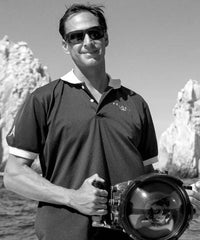 Ambassador David Valencia is a PADI certified diver and author. He’s contributed to magazines like Sport Diver and Scuba Diving. David has been diving for over twenty years, and picked up his love of underwater photography by way of wanting to share the interesting things he sees while diving. David is an advocate for conservation and believes underwater photography can help bring awareness to this issue. Read more...
Ambassador David Valencia is a PADI certified diver and author. He’s contributed to magazines like Sport Diver and Scuba Diving. David has been diving for over twenty years, and picked up his love of underwater photography by way of wanting to share the interesting things he sees while diving. David is an advocate for conservation and believes underwater photography can help bring awareness to this issue. Read more...
David would like to extend a special thanks to the great staff at Cabo Pulmo Beach Resort.

Additional Reading
Behind the Shot: Swirling Mobulas in Southern Baja Mexico
Shark Photography Underwater Camera Settings
Protecting the Natural Resources of the Bahamas with Bahamas Girl
Cousteau's Aquarium | Sea of Cortez with the Nikon Z6
Crocodiles, Cenotes, and Chinchurro with Ken and Kimber Kiefer











